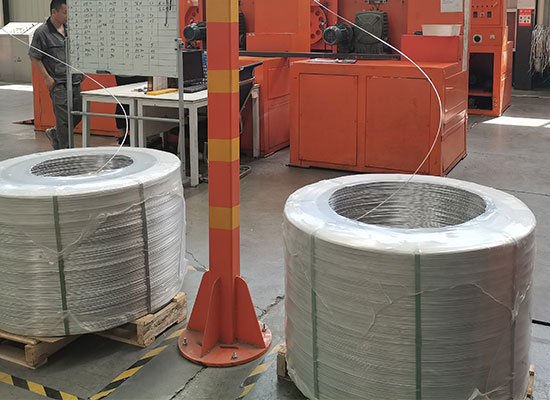Aluminum wire is the most common metal in electric power transmission and distribution. Although only 61% of the conductivity of copper by cross-sectional area, its lower density makes it twice as conductive by mass. As aluminum is roughly one-third the cost of copper by weight, the economic advantages are considerable when large conductors are required.

The disadvantages of aluminum wiring lie in its mechanical and chemical properties. It readily forms an insulating oxide, making connections heat up. Its larger coefficient of thermal expansion than the brass materials used for connectors causes connections to loosen. Aluminum can also “creep”, slowly deforming under load, which also loosens connections. These effects can be mitigated with suitably designed connectors and extra care in installation, but they have made aluminum building wiring unpopular past the service drop.
Aluminium wire is almost always alloyed, which markedly improves its mechanical properties, especially when tempered. For example, the common aluminium foils and beverage cans are alloys of 92% to 99% aluminium. The main alloying agents are copper, zinc, magnesium, manganese, and silicon (e.g., duralumin) with the levels of other metals in a few percent by weight. Aluminium, both wrought and cast, has been alloyed with: manganese, silicon, magnesium, copper and zinc among others.For example, the Kynal family of alloys was developed by the British chemical manufacturer Imperial Chemical Industries.
The major uses for aluminium metal are in:
Transportation (automobiles, aircraft, trucks, railway cars, marine vessels, bicycles, spacecraft, etc.). Aluminium is used because of its low density;
Packaging (cans, foil, frame, etc.). Aluminium is used because it is non-toxic (see below), non-adsorptive, and splinter-proof;
Building and construction (windows, doors, siding, building wire, sheathing, roofing, etc.). Since steel is cheaper, aluminium is used when lightness, corrosion resistance, or engineering features are important;
Electricity-related uses (conductor alloys, motors, and generators, transformers, capacitors, etc.). Aluminium is used because it is relatively cheap, highly conductive, has adequate mechanical strength and low density, and resists corrosion;
A wide range of household items, from cooking utensils to furniture. Low density, good appearance, ease of fabrication, and durability are the key factors of aluminium usage;
Machinery and equipment (processing equipment, pipes, tools). Aluminium is used because of its corrosion resistance, non-pyrophoricity, and mechanical strength.
Portable computer cases. Currently rarely used without alloying, but aluminium can be recycled and clean aluminium has residual market value: for example, the used beverage can (UBC) material was used to encase the electronic components of MacBook Air laptop, Pixel 5 smartphone or Summit Lite smartwatch.
